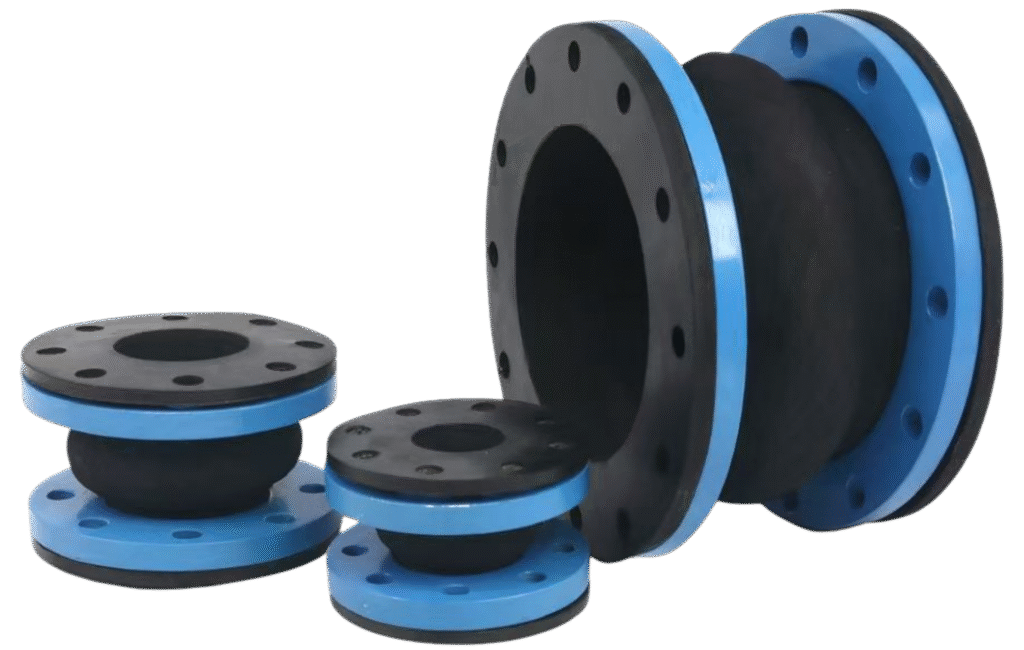FAQ’S
Home > FAQ’S
Rubber Joint and Vibration Isolator Manufacturer
We offer a wide range of products, including rubber expansion joints, spring vibration isolators, rubber shock pads, metal bellows, stainless steel flexible hoses, and automotive shock absorbers. These products are widely used in fans, pumps, HVAC units, diesel generator sets, test benches, power equipment, aerospace, and other industries.
Learn about our frequently asked questions regarding rubber expansion joints, spring vibration isolators, and customized products — including material selection, application fields, delivery lead time, certifications, and more — to quickly find the answers you’re looking for.
Yes, we are a professional manufacturer with our own R&D and production facilities. Our factory is located in the Shuangdian Industrial Park, Nantong, Jiangsu Province. It covers a large area and is equipped with advanced automated machinery. Our annual production capacity reaches 1.2 million vibration control products.
We have passed ISO9001, ISO14001, and OHSAS18001 management system certifications. Our products are also certified by international authorities such as ABS (USA) and TÜV (Germany). In addition, we hold various professional test reports, including food-grade testing, water immersion tests, type testing, and fire resistance tests.
Yes, we offer customization services. With a strong in-house design and development team, we can provide tailored solutions based on your drawings, samples, or specific usage requirements. Simply provide us with your operating conditions (temperature, pressure, medium, dimensions, etc.), and we will deliver one-on-one design support and technical assistance.
We adhere to the philosophy that “Quality is life.” Our factory is equipped with a comprehensive testing center and advanced testing instruments, including fatigue testing machines, burst pressure testers, chloride ion detectors, and vibration simulation benches. Every batch of products undergoes rigorous inspection to ensure that only qualified items are delivered to our clients.
Absolutely. We welcome both domestic and international customers to schedule a visit. We can accommodate your preferred time and provide a full tour of our production process and testing procedures to strengthen mutual trust and cooperation.
Trusted and Professional Services and help
At Songjiangflex, we stand behind our products with a solid after-sales system. Whether it's a service request during holidays or a critical quality issue, our team responds within hours—not days. With industry-leading vibration damping of up to 80%, testing support, and a five-year warranty, we provide total confidence for every installation.
Our products achieve up to 80% vibration damping before and after use. We also support testing before and after installation to verify performance.
We offer a five-year warranty for indoor use, covering performance assurance and quality stability.
If a quality issue arises, we’ll respond in writing within 12 hours and provide a solution plan within 24 hours. If the issue is confirmed as inherent, we’ll cover shipping and offer a free replacement.




What our customer says
We believe that the best proof of quality comes from those who have experienced it firsthand. That’s why we’re proud to share real feedback from our global clients—engineers, project managers, and distributors—who trust Songjiangflex for reliable vibration control solutions. Their satisfaction is the greatest recognition of our commitment to excellence.

Mr. John Carter
Maintenance Manager, USA
We appreciated their quick response, high-quality rubber expansion joints, and professional, reliable service from start to finish.

Ms. Natalia K.
Project Manager, Poland
The team responded within 12 hours when we encountered a shipment issue. We received a solution plan the next morning. Very professional and trustworthy.

Ms. Liu Wei
HVAC Distributor, China
The five-year warranty gives us peace of mind. We’ve been cooperating for three years, and the performance remains stable.
What are rubber expansion joints used for?
Rubber expansion joints are flexible connectors used in piping systems to absorb movement, reduce vibration, and minimize noise—ensuring long-term system performance and equipment protection. They play a critical role in both industrial and commercial applications where temperature, pressure, or mechanical forces cause pipes to shift or expand.
Key Functions of Rubber Expansion Joints:
Absorbing Thermal Expansion and Contraction
When pipelines are exposed to temperature changes, rubber expansion joints help accommodate axial (lengthwise), lateral (side-to-side), and angular movements to prevent stress and damage.Reducing Vibration and Mechanical Stress
Installed between pumps, compressors, or other vibrating equipment and pipelines, these joints isolate vibrations, protecting connected components from premature wear or failure.Noise Suppression
Rubber’s inherent flexibility and damping properties help minimize noise generated by fluid flow, pressure fluctuations, or mechanical activity within the system.Compensating for Misalignment
They allow for slight deviations in pipe alignment during installation, reducing the need for precise adjustments and improving installation efficiency.Protecting System Integrity
By absorbing shock and relieving stress, rubber expansion joints help extend the lifespan of piping systems, valves, and equipment.
Typical Applications of Rubber Expansion Joints
HVAC systems
Water and wastewater treatment
Power plants and boiler systems
Chemical and petrochemical pipelines
High-rise building plumbing and fire protection systems
Marine and offshore structures
These joints are especially important in systems subject to high vibration, frequent temperature fluctuations, or tight installation spaces.
How long do rubber expansion joints typically last?
Rubber expansion joints generally last between 5 to 10 years, but their actual service life depends heavily on factors such as operating pressure, temperature, media compatibility, and maintenance practices. With proper installation and routine inspections, their lifespan can often be extended beyond the typical range.
Key Factors That Influence Lifespan:
Operating Environment
Exposure to harsh chemicals, high temperatures, or UV radiation can accelerate aging. For indoor HVAC or clean water systems, joints may last closer to 10 years; for outdoor or corrosive environments, the life may be shorter.Material Selection
Choosing the right rubber material (e.g., EPDM, NBR, Neoprene, or Viton) based on the conveyed medium is critical. Incorrect material selection can cause early failure.Installation Quality
Improper alignment, overtightening, or lack of movement allowance during installation can lead to stress concentrations and premature wear.Maintenance and Inspection
Regular visual checks for cracking, blistering, or hardening can help detect early signs of degradation. Proactive maintenance can prevent system failure and prolong service life.
How to Extend the Lifespan of Rubber Expansion Joints
Ensure correct material and model selection for your specific media and conditions
Install with proper alignment and support
Avoid excessive torsion or elongation
Inspect every 6–12 months, especially in critical systems
Replace when signs of wear, leakage, or deformation appear
Our engineers can guide you based on your application’s pressure, temperature, and media requirements to ensure safe and durable performance.
Can rubber expansion joints withstand high pressure? Are they suitable for high-pressure piping systems?
Yes, rubber expansion joints can be reinforced during design and manufacturing to suit various working conditions, with certain models specifically developed for high-pressure environments. For example, in petrochemical plants, power stations, and high-rise building water supply systems, we often use expansion joints with high-strength reinforcement layers, thickened rubber walls, and flange reinforcements to ensure stable performance under significant pressure.
However, whether a rubber expansion joint is suitable for high-pressure systems depends on several key factors:
Rubber Material Selection: Different materials (such as EPDM, NBR, or Viton) offer varying resistance to pressure, temperature, and media.
Reinforcement Structure: Nylon cord fabric, steel wire layers, and other reinforcements determine the pressure rating.
Wall Thickness and Size: High-pressure systems usually require thicker walls and a higher safety factor.
Matching Flanges and Installation: Improper installation can compromise pressure resistance.
Therefore, when selecting a rubber expansion joint, it is essential to provide specific parameters such as working pressure, temperature, media, and installation method. Our technical team will recommend the most suitable high-pressure model to ensure safe operation of your system.
If you have high-pressure requirements, feel free to contact us for free model selection advice and technical support.
What advantages do PTFE expansion joints offer?
PTFE expansion joints offer exceptional advantages when it comes to handling aggressive chemicals, high temperatures, and demanding pipeline systems. Their core benefits include:
Outstanding Chemical Resistance: PTFE (Polytetrafluoroethylene) is virtually inert to most acids, alkalis, and solvents. This makes PTFE expansion joints the go-to solution for pipelines transporting corrosive fluids in industries like chemical processing, pharmaceuticals, and wastewater treatment.
High Temperature Tolerance: PTFE can withstand continuous service temperatures up to 260°C (500°F), making it suitable for both hot media and environments where thermal stability is critical.
Non-stick and Low Friction Properties: The extremely low friction coefficient of PTFE prevents buildup and blockage within the pipeline, reducing maintenance needs and ensuring smooth flow of materials.
Flexible and Fatigue-Resistant: PTFE expansion joints can absorb axial, lateral, and angular movements caused by thermal expansion, vibration, or equipment misalignment, while maintaining long-term durability under cycling conditions.
Sanitary and Non-contaminating: PTFE is food-grade and non-toxic, making it suitable for hygienic applications in food processing and biotech systems where purity is essential.
When selecting a PTFE expansion joint, consider factors like pressure rating, temperature range, and media compatibility. For complex environments, we recommend a consultation with our technical team to ensure optimal performance and safety.
Are PTFE expansion joints flexible enough for pipeline movement?
Yes, PTFE expansion joints are specifically engineered to handle pipeline movement with excellent flexibility and chemical resistance. While PTFE on its own is rigid and non-elastic, it is typically used as a lining material inside a flexible outer body made from rubber or fabric-reinforced materials. This combination provides both protection and flexibility.
Key Benefits of Flexibility in PTFE Expansion Joints:
Absorbs Axial, Lateral, and Angular Movements
PTFE expansion joints are capable of compensating for expansion and contraction caused by temperature fluctuations, vibration, misalignment, or equipment motion.Maintains Seal Integrity
Even under stress or movement, the joint maintains a tight seal, reducing the risk of leakage in critical systems.Prevents Pipe Stress and Fatigue
By absorbing movement, it minimizes stress transmission to adjacent piping, valves, and pumps, thereby extending the system’s overall service life.Ideal for Corrosive and Dynamic Environments
Commonly used in systems transporting aggressive chemicals at varying temperatures and pressures—such as in chemical plants, wastewater treatment facilities, and high-purity fluid systems.
When selecting the right joint, consider not just the media but also the amount and type of movement (axial, lateral, angular) expected in the system.
Can PTFE expansion joints be used in food and pharmaceutical industries?
Absolutely. PTFE expansion joints are highly suitable for food and pharmaceutical applications due to their sanitary, non-toxic, and chemically inert properties. These joints help maintain cleanliness, prevent contamination, and meet strict regulatory standards in hygienic processing environments.
Why PTFE Expansion Joints Are Ideal for Hygienic Industries:
Chemical Inertness
PTFE (Polytetrafluoroethylene) does not react with most chemicals, acids, or solvents, making it ideal for transporting sensitive or high-purity materials used in food and pharmaceutical production.Non-toxic and FDA-compliant
PTFE is a food-grade, non-toxic material. Many PTFE expansion joints meet FDA, USP Class VI, or EU food safety standards, ensuring compatibility with consumable and injectable products.Smooth, Non-stick Interior
The ultra-smooth inner surface resists bacterial growth, prevents residue buildup, and is easy to clean—critical for sanitary process lines that require frequent cleaning or sterilization.High Temperature Resistance
PTFE can withstand cleaning processes like steam sterilization and CIP (clean-in-place), maintaining performance under thermal stress.
Before selection, be sure to confirm required certifications (such as FDA or USP compliance) and specify process conditions like pressure, temperature, and cleaning procedures.
What is a hand-wrapped rubber expansion joint?
A hand-wrapped rubber expansion joint is a custom-engineered joint manufactured by manually layering rubber sheets and reinforcing fabrics to meet specific application requirements. Unlike mass-produced molded joints, the hand-wrapped process allows greater flexibility in size, wall thickness, pressure rating, and material selection.
Key Characteristics of Hand-Wrapped Rubber Expansion Joints:
Customizable Construction
Each joint is made by hand-laying multiple layers of rubber and reinforcement fabric (such as nylon or polyester), allowing precise control over the product’s performance and dimensions.Enhanced Durability and Strength
Hand-wrapping enables targeted reinforcement in high-stress areas, making these joints suitable for heavy-duty or high-pressure applications.Material Versatility
Rubber types such as EPDM, NBR, Neoprene, or Viton can be selected based on the fluid medium, temperature, and chemical exposure.Large Diameter Capability
Ideal for large-diameter pipelines (often above DN600), where standard molded joints are unavailable or impractical.Flexible Production for Special Requirements
Can be designed with special face-to-face lengths, flange drilling patterns, or multi-arch configurations as needed.
Common Applications of Hand-Wrapped Rubber Expansion Joints
These joints are widely used in:
Power plants and boiler systems
Municipal water supply and drainage
Chemical and petrochemical industries
Mining and slurry transport systems
Large industrial HVAC systems
Their ability to handle high loads, harsh conditions, and custom specifications makes them ideal for non-standard or engineered piping systems.
How does hand-wrapped production affect product quality?
Hand-wrapped production significantly enhances the quality and reliability of rubber expansion joints by allowing precise control over material layering, reinforcement placement, and overall construction. This manual process is especially valuable in custom-engineered applications where standard molded products may fall short.
Advantages of Hand-Wrapped Manufacturing for Product Quality:
Precision Layering for Structural Integrity
Each layer of rubber and reinforcing fabric (such as nylon cord or aramid fiber) is manually positioned, ensuring even thickness, proper alignment, and optimal bonding. This results in greater tensile strength and pressure resistance.Tailored Reinforcement Placement
Critical stress areas—such as the arch base or flange connection—can be reinforced with extra fabric layers, enhancing durability in high-pressure or vibration-heavy systems.Superior Adhesion and Flexibility
Manual rolling and curing techniques promote excellent bonding between layers, reducing the risk of delamination and improving the product’s ability to absorb movement and vibration.Custom Fit for Complex Installations
Hand-wrapped production supports non-standard sizes, variable face-to-face lengths, unique flange drilling, and multi-arch configurations, allowing joints to fit seamlessly into challenging systems.High Quality Control at Every Stage
Each joint is individually built and inspected, providing more rigorous quality oversight compared to high-speed automated molding processes.
When Is Hand-Wrapped Production Recommended?
For large-diameter pipelines (DN600 and above)
When special design parameters are required (e.g., high pressure, unusual flange layout)
In applications involving corrosive media, strong vibration, or repeated thermal cycling
Where long-term performance and safety are critical
Choose hand-wrapped rubber expansion joints for reliable quality, extended service life, and custom-fit solutions. Contact us today for expert design support and tailored product recommendations.
Is the lead time longer for hand-wrapped joints?
Generally, yes. Hand-wrapped rubber expansion joints require more time to manufacture compared to molded or machine-made joints due to the intensive manual labor involved in layering rubber sheets and reinforcing fabrics. This handcrafted process ensures high customization and precise control over product specifications, which can take additional production time.
Why Does Hand-Wrapping Take Longer?
Manual Layering and Assembly:
Each layer of rubber and reinforcement fabric is carefully applied by skilled workers to meet exact design requirements.Customized Specifications:
Hand-wrapped joints are often made to order with specific dimensions, pressure ratings, and reinforcement patterns that require detailed craftsmanship.Quality Assurance:
The individual attention during production and inspection adds time but guarantees superior durability and performance.
Balancing Lead Time and Benefits
While the lead time may be longer, the benefits of hand-wrapped joints—including tailored fit, enhanced durability, and suitability for complex applications—often outweigh the extra wait. For critical or non-standard pipeline systems, this investment in quality and customization is essential.
Need help with delivery schedules or product customization?
Contact our sales and engineering team to discuss your project timeline and find the best solution that balances lead time and performance.
What applications are fabric expansion joints best suited for?
Fabric expansion joints are specially designed for high-temperature and corrosive environments where flexibility and thermal resistance are critical. Their construction allows them to absorb movements and vibrations in ducting systems that carry hot gases and exhaust fumes.
Key Applications of Fabric Expansion Joints:
Power Plants and Boilers
Commonly used in flue gas ducts and exhaust systems to accommodate thermal expansion and reduce vibration caused by turbines, boilers, and fans.Industrial Furnaces and Kilns
Fabric joints withstand extreme temperatures and chemical exposure, making them suitable for furnace exhausts and refractory systems.Cement and Steel Plants
Used in dust collection and exhaust ductwork where high temperature, abrasive particles, and chemical corrosion occur.Incinerators and Waste-to-Energy Plants
Provide flexibility and sealing for ducts carrying hot combustion gases, improving system longevity.HVAC Systems with High-Temperature Airflows
Maintain airtight connections while compensating for thermal movements and equipment vibrations.
Need help selecting the right fabric expansion joint for your high-temperature system?
Contact our technical team for expert advice and customized solutions tailored to your operating conditions.
How do fabric expansion joints compare to metal ones?
Fabric expansion joints and metal expansion joints each have distinct advantages and limitations, making them suitable for different applications based on operating conditions and performance requirements.
Advantages of Fabric Expansion Joints:
Lightweight and Flexible: Fabric joints are significantly lighter than metal ones, making installation easier and reducing structural load.
Excellent Thermal Movement Absorption: They can accommodate greater axial, lateral, and angular movements caused by thermal expansion and vibration.
Superior Vibration and Noise Dampening: Their flexible nature helps reduce vibration transmission and operational noise.
Corrosion and Abrasion Resistance: With appropriate material choices, fabric joints can withstand corrosive and abrasive gases better than some metal joints.
Advantages of Metal Expansion Joints:
High Pressure and Mechanical Strength: Metal joints can handle much higher pressures and mechanical loads, making them ideal for high-pressure or heavy-duty piping systems.
Longer Service Life in Harsh Environments: Metal joints generally withstand extreme temperatures and mechanical wear better.
Tighter Sealing: Metal bellows provide reliable sealing under varying pressures and temperatures.
Need help selecting the right expansion joint for your system?
Contact our technical team for expert advice tailored to your specific application and operating conditions.
What materials are commonly used in fabric expansion joints?
Fabric expansion joints are constructed from multiple layers of specialized materials designed to withstand high temperatures, chemical exposure, and mechanical stress. The choice of materials depends on the specific operating environment and performance requirements.
Common Materials Used in Fabric Expansion Joints:
High-Temperature Resistant Fabrics:
Fiberglass Fabric: Widely used for its excellent heat resistance, typically up to 550°C (1022°F).
PTFE-Coated Fiberglass: Offers superior chemical resistance and can handle temperatures up to 260°C (500°F).
Silicone-Coated Fiberglass: Provides flexibility and resistance to high temperatures and weathering, suitable for up to 300°C (572°F).
Rubber or Elastomer Seals:
Used in combination with fabric layers to provide airtight sealing and flexibility. Common elastomers include EPDM, Neoprene, and Viton, chosen based on chemical compatibility and temperature resistance.Insulation and Reinforcement Layers:
Some fabric joints incorporate insulation layers or metal reinforcements to enhance durability and thermal performance.
Why Material Choice Matters
Selecting the right materials ensures the expansion joint can handle the system’s temperature, pressure, chemical exposure, and movement without premature failure, thus protecting the piping system and ensuring long service life.Contact our technical team for expert advice and tailored solutions.


